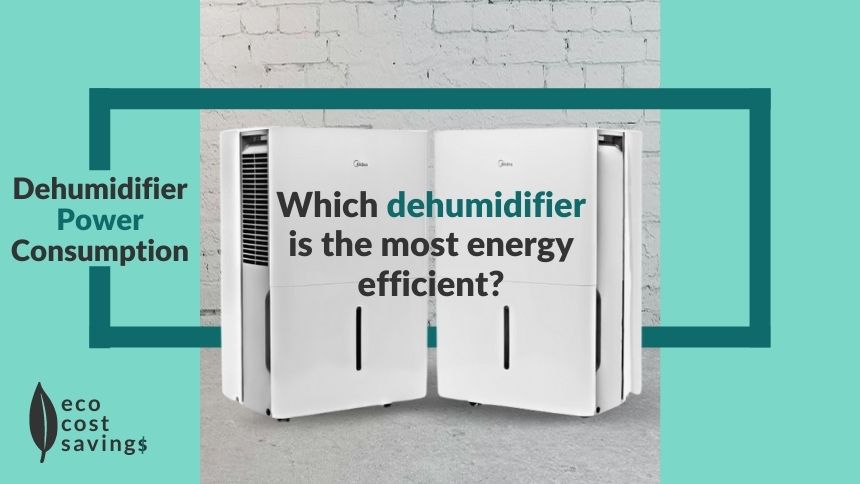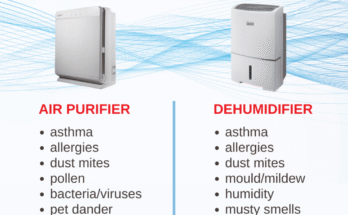Are you curious about how much electricity your dehumidifier uses each month? You’re not alone.
Many homeowners like you want to keep their homes comfortable without breaking the bank. Understanding the energy consumption of your appliances is a smart step towards managing your monthly bills. We’ll break down the electricity usage of dehumidifiers, offering you clear insights and practical tips.
By the end, you’ll know exactly how to balance comfort and cost-effectiveness. Keep reading, and let’s save some energy together!

Factors Affecting Dehumidifier Power Usage
Understanding the power usage of a dehumidifier can save costs. Several factors affect how much electricity your dehumidifier uses each month. Let’s explore these factors to help you estimate usage more accurately.
Size And Capacity
The size and capacity of a dehumidifier greatly impact its power use. Larger units often consume more electricity. They have higher capacities and can handle bigger spaces. Smaller units might use less power but may run longer to achieve desired humidity levels.
Humidity Levels
Humidity levels in your area influence electricity consumption. High humidity makes the dehumidifier work harder. It runs longer to remove excess moisture. This increases energy usage. A moderate humidity level means less energy consumption.
Operating Environment
The environment where the dehumidifier operates matters. A room with poor ventilation increases power usage. The unit has to work harder to maintain ideal humidity. A well-ventilated space helps reduce electricity needs.
Usage Patterns
How often and how long you use the dehumidifier affects power consumption. Frequent use increases electricity bills. Running the unit only when necessary conserves energy. Using a timer can help manage usage effectively.
Calculating Monthly Electricity Consumption
A dehumidifier’s monthly electricity use depends on its wattage and hours of operation. Calculate usage by multiplying the device’s wattage by the number of hours it’s used and dividing by 1,000 for kilowatt-hours. Estimating costs helps manage energy bills effectively.
Calculating the monthly electricity consumption of a dehumidifier helps manage costs. Understanding how much energy your device uses can lead to savings. Let’s break down the process into three simple steps.
Wattage Rating
Wattage rating indicates how much power a dehumidifier uses. Check your device’s label or manual for this information. Most home dehumidifiers range between 300 to 700 watts. Knowing the wattage is key to calculating energy use.
Daily Operational Hours
Determine how many hours your dehumidifier runs daily. Some run continuously, others only during humid conditions. Estimate the average number of hours per day. This will be crucial for monthly calculations. Keeping track helps optimize usage.
Electricity Cost Per Kwh
Electricity cost per kilowatt-hour (kWh) varies by region. Check your utility bill for this rate. Multiply the dehumidifier’s energy use by the cost per kWh. This gives an estimate of monthly expenses. Awareness of rates can lead to better budget management.
Comparing Different Dehumidifier Models
Choosing the right dehumidifier affects your electricity bill. Different models consume different amounts of electricity. Understanding these differences helps you make an informed decision. Let’s explore how various dehumidifiers compare in terms of energy use.
Energy Efficiency Ratings
Energy efficiency ratings show how well a dehumidifier uses power. Higher ratings mean less electricity use. Check the Energy Star label. This label indicates the model meets strict efficiency standards. Efficient models save money and reduce carbon footprint.
Smart Features And Controls
Modern dehumidifiers come with smart features. These include timers, humidity sensors, and remote controls. Such features help manage energy use. Automated controls adjust settings based on room conditions. This reduces unnecessary power consumption.
Portable Vs. Whole-house Models
Portable dehumidifiers are easy to move. They are ideal for single rooms. They use less electricity than whole-house models. Whole-house dehumidifiers cover larger areas. They connect to HVAC systems. They consume more electricity but offer broad coverage.

Tips To Reduce Power Usage
Dehumidifiers are essential for maintaining a comfortable home environment. But many worry about electricity usage. Luckily, you can reduce power consumption with a few simple tips. These methods will help you save energy and lower your monthly bills.
Optimal Settings
Set your dehumidifier to the right humidity level. Aim for 30% to 50% humidity. This range keeps your home dry without using excess electricity. Use timers or smart plugs to operate during off-peak hours. Avoid using the highest setting unless necessary.
Regular Maintenance
Keep your dehumidifier clean and in good condition. Dust and dirt can make it work harder, using more energy. Clean the air filter regularly. Check for any leaks or blockages. Proper maintenance improves efficiency and reduces power usage.
Alternative Moisture Control Methods
Consider other ways to manage humidity. Use fans to circulate air. Ventilate bathrooms and kitchens after use. Houseplants can help absorb moisture. These methods can reduce reliance on dehumidifiers, cutting electricity costs.
Environmental Impact Considerations
Understanding the environmental impact of dehumidifiers can guide responsible usage. While dehumidifiers help maintain comfort, they also consume energy. This consumption impacts the environment. Assessing their carbon footprint and exploring sustainable practices can minimize harm.
Carbon Footprint Of Dehumidifiers
Dehumidifiers use electricity, contributing to carbon emissions. Their impact varies by model and usage. Older models may use more energy. This leads to a larger carbon footprint. Energy-efficient models reduce this impact. They consume less electricity, lowering emissions. Regular maintenance also helps. Clean filters improve efficiency, reducing energy use.
Renewable Energy Options
Switching to renewable energy can lessen a dehumidifier’s environmental impact. Solar and wind power are cleaner alternatives. They provide electricity without harmful emissions. Using green energy with your dehumidifier reduces its carbon footprint. Some utilities offer renewable energy plans. Check with your provider for options.
Sustainability Practices
Adopting sustainable practices can further reduce environmental impact. Use your dehumidifier only when necessary. This conserves energy and extends the device’s lifespan. Set the humidity level appropriately. Avoid excessively low settings. Regular maintenance ensures optimal performance. Clean or replace filters as needed. Consider recycling old units responsibly. Many programs offer recycling for appliances. This prevents electronic waste.

Frequently Asked Questions
Do Dehumidifiers Run Up Your Electric Bill?
Dehumidifiers can increase your electric bill, but the impact varies by model and usage frequency. Energy-efficient models are available and can minimize costs. Regular maintenance ensures optimal performance and efficiency, helping to keep electricity expenses manageable. Always check energy ratings before purchasing a dehumidifier to control energy consumption effectively.
How Much Does It Cost To Run A Dehumidifier 24 7?
Running a dehumidifier 24/7 can cost between $10 to $60 monthly. Costs vary based on unit efficiency and electricity rates. Energy-efficient models reduce expenses. Check your local electricity rates for precise calculations.
Is It Cheaper To Run A Dehumidifier Or Heating?
Running a dehumidifier is generally cheaper than heating. It uses less energy and reduces moisture, enhancing comfort. Heating costs vary based on climate and insulation. Dehumidifiers can help lower heating expenses by keeping air dry, allowing for lower thermostat settings.
Consider energy-efficient models for cost savings.
Do Dehumidifiers Use A Lot Of Power?
Dehumidifiers typically use moderate power. Most models consume around 300-700 watts. Energy-efficient models are available. Proper usage can minimize energy costs. Always check the unit’s wattage and Energy Star rating.
Conclusion
Understanding dehumidifier electricity use helps manage monthly bills. Choose energy-efficient models for savings. Regular maintenance improves performance and reduces costs. Monitor usage to prevent unexpected expenses. Consider room size and humidity levels when selecting a dehumidifier. Smaller spaces need less power.
Larger areas require more. Balance efficiency with needs. Awareness leads to better choices and savings. Keep an eye on your energy usage. Make informed decisions. Stay smart about appliance consumption. Save money while keeping your home comfortable. Your wallet will thank you.
Choose wisely for a healthier, more cost-effective home environment.



